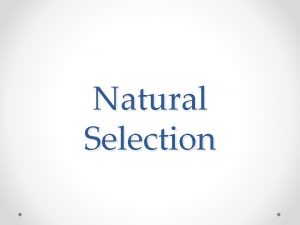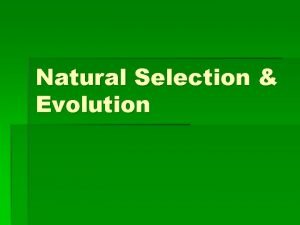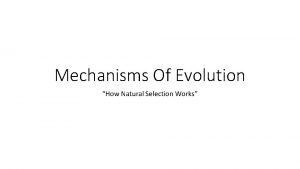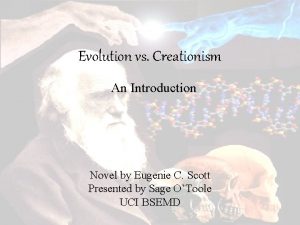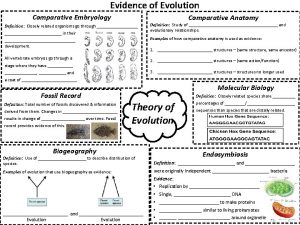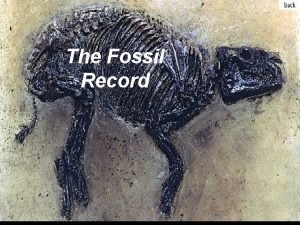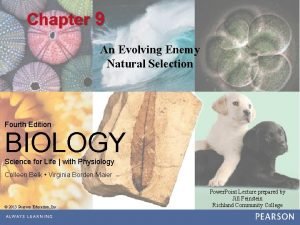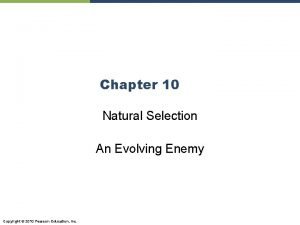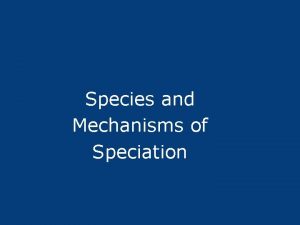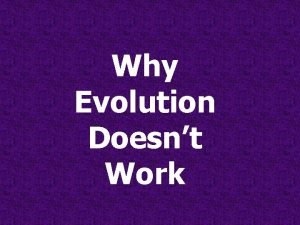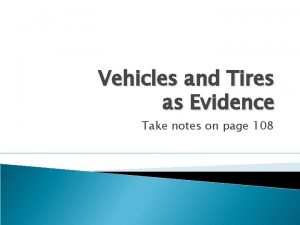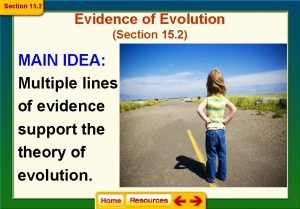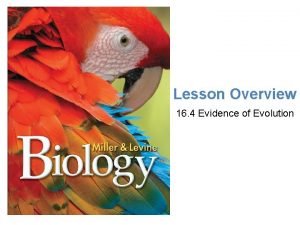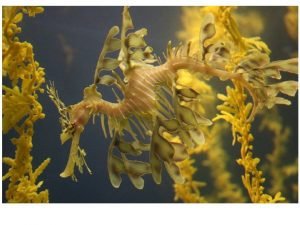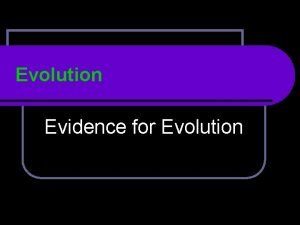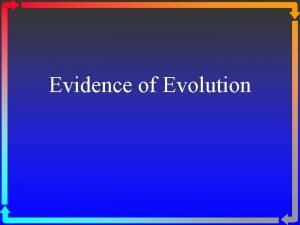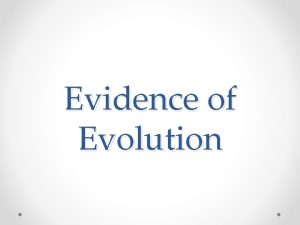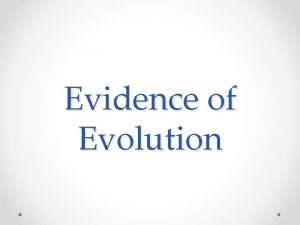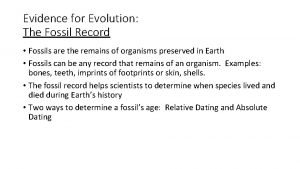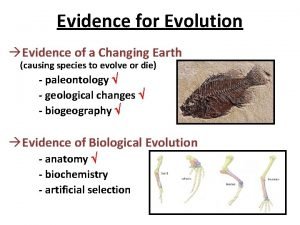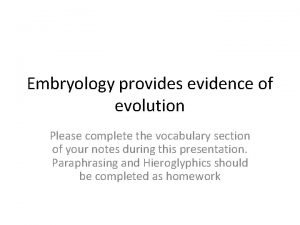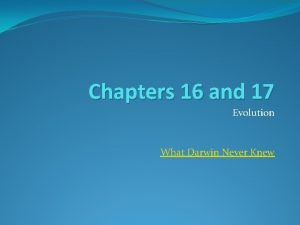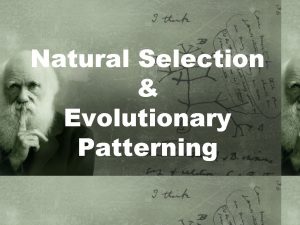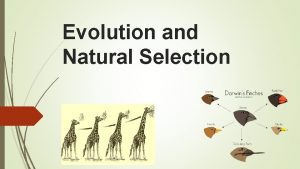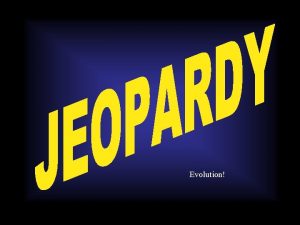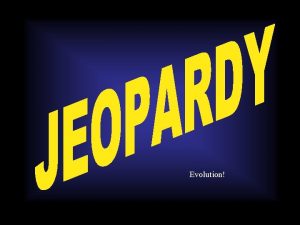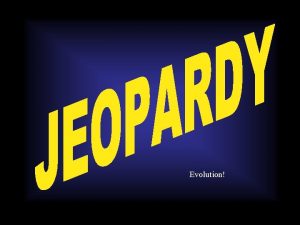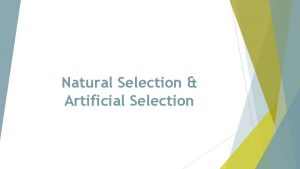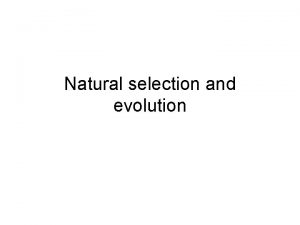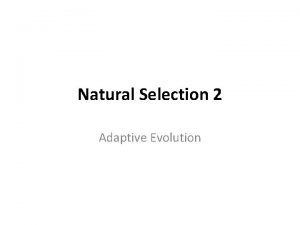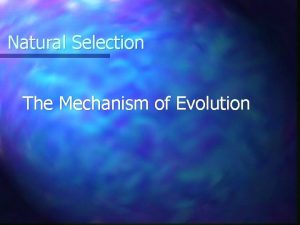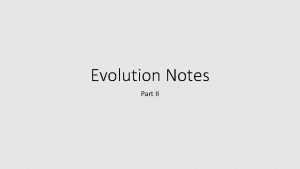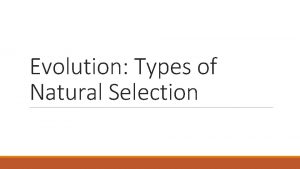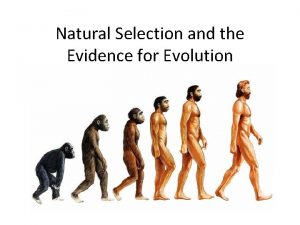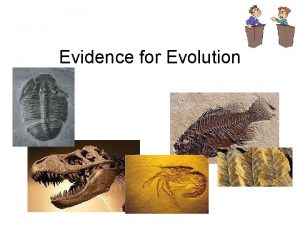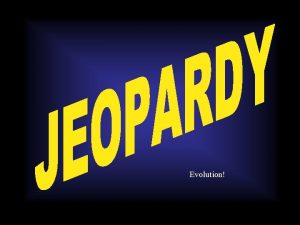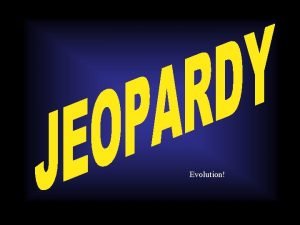Evolution Natural Selection and Evidence for Evolution 1












































- Slides: 44

Evolution Natural Selection and Evidence for Evolution 1

Life • How did we come from this? • To this. 2

What is Evolution? • Change in a population over a long time or MANY generations • A population is a group of a single species – Humans…or Lions • Evolution occurs through Natural Selection (“That is the Key!”) 3

What is a Species? • A Species is defined as a group of organisms that share similar characteristics and that are capable of interbreeding and producing fertile offspring 4

Lamarck • French scientist Jean Baptiste de Lamarck (1744 – 1829) • First to propose a unifying hypothesis of species modification • Acquired Traits – trait that is not determined by genes • Lamarck – these were passed on to offspring 5

Charles Darwin • Darwin – – individuals struggle to survive • (competing for food and space, escaping predators, finding mates, locating shelter). – Only some individuals survive the struggle and produce offspring 7

Charles Darwin • Darwin – – Descent with Modification – Modification by Natural Selection 8

Darwin and Natural Selection • Four things that drive N. S. – Fitness • Ability to survive and reproduce – Variation • Differences among species – Adaptation • Variation that improves chances of survival • Adaptations develop over many generations – Competition • Fight for survival (food, shelter) 9

Selection • Artificial Selection – Breeding organisms with specific traits • Natural Selection – Mechanism for change in population – Organisms with certain variations survive, reproduce and pass their traits to offspring • Survival of the Fittest! 10

Variation A variation is an inherited trait that makes an individual different from other members of the species. Some traits are “better” or more favorable than others 11

Adaptation • Adaptation: any variation that aids an organism’s chances of survival in its environment 12

Evidence of Evolution 1. Structural Adaptation: – allow a species to defend against predation. Monarch – Mimicry: • The ability species to resemble another species; two types. Viceroy – Camouflage: • The ability of species to blend in with their surroundings 13

What is this? 14

Structural Adaptations cont • Mimicry 15

Leafhoppers 16

Treehopper 17

Leaf Hopper 18

Ants 19

Warning Coloration 20

Other Evidence 2. Physiological Adaptations: – Develop rapidly…(antibiotic resistance; pesticide resistance) – This is Direct Evidence • 3 – 6. Indirect Evidence 21

3. Fossils • Fossils show evolutionary history 22

23

24

4. Anatomy • Homologous Structures – Common ancestry • Analogous Structures – No Common ancestry • Vestigial Structures – No visible function or use any longer 25

Anatomy Revisited • Homologous Structures – Common Ancestor – Can have similar arrangement and function • Analogous Structures – No common ancestor – Similar function; different anatomy 26

Vestigial Structures • Flightless Cormorant 27

Vestigial Structures • Human Ear Muscles • Baleen Whale Pelvic Bone • Vestigial Video 28

29

5. Embryology • Similarities in Embryos – Suggest a common ancestor 30

Embryology and Evolution 31

6. Biochemistry • Comparison of DNA and RNA • Determine evolutionary relationship 32

Evolution and History How Evolution Happens - You. Tube 33

Industrial Melanism • Peppered moths – • Before the Industrial Revolution • After the Industrial Revolution 34

35

36

Mechanisms of Evolution 37

Disruption of Equilibrium shows Evolution • Mutation – change in the DNA of an organism • Genetic Drift – Alleles frequency changes by random events or chance • Non-Random Mating – Assortative Mating – Selection of mate based on similar characteristics • Migration – into or out of population – Gene Flow: genes moving from one pop to another • Natural Selection – See Below 38

Assortative Mating 39

Review Natural Selection • Natural Selection – – The idea that organisms with traits best suited to their environment are more likely to survive and reproduce 40

Types of Natural Selection • Stabilizing Selection – Favors average individuals • Disruptive Selection – Favors both extremes of a variation • Directional Selection – Favors a single extreme variation 41

42

Speciation • What is Speciation? – The evolution of new species • Geographic Isolation – Occurs when a small part of the population becomes separated; over generations, different variations become more common • Reproductive Isolation – Members of a species change from one another over time so much that they can no longer reproduce fertile offspring 43

How long does speciation take? • Gradualism – The model that describes evolution as a slow ongoing process • Punctuated Equilibrium – States that rapid evolution comes about when the mutations of a few genes results in the appearance of a new species over a relatively short period of time 44

Patterns of Evolution • Divergent Evolution – Adaptive Radiation – Single species evolves into an array • Convergent Evolution – The acquisition of the same biological trait in unrelated lineages 45
 What's natural selection
What's natural selection Artificial selection vs natural selection
Artificial selection vs natural selection Natural selection vs artificial selection
Natural selection vs artificial selection Difference between continuous and discontinuous variation
Difference between continuous and discontinuous variation What is artificial selection
What is artificial selection Natural selection vs artificial selection
Natural selection vs artificial selection Types of natural selection in evolution
Types of natural selection in evolution Mechanisms evolution
Mechanisms evolution Natural selection vs evolution
Natural selection vs evolution Difference between class evidence and individual evidence
Difference between class evidence and individual evidence Two way selection and multiway selection
Two way selection and multiway selection Two way selection and multiway selection in c
Two way selection and multiway selection in c Mass selection and pure line selection
Mass selection and pure line selection Anatomy and embryology evidence of evolution
Anatomy and embryology evidence of evolution Evidence of evolution of remnants and impressions *
Evidence of evolution of remnants and impressions * Natural selection and drug resistance
Natural selection and drug resistance Natural selection
Natural selection Secondary sources
Secondary sources Primary evidence vs secondary evidence
Primary evidence vs secondary evidence Primary evidence vs secondary evidence
Primary evidence vs secondary evidence Primary evidence vs secondary evidence
Primary evidence vs secondary evidence Primary evidence vs secondary evidence
Primary evidence vs secondary evidence Are fibers class evidence
Are fibers class evidence Class evidence vs individual evidence
Class evidence vs individual evidence Class and individual evidence
Class and individual evidence The ecological fallacy
The ecological fallacy Balancing selection vs stabilizing selection
Balancing selection vs stabilizing selection K selection r selection
K selection r selection What is exponential growth in ecology
What is exponential growth in ecology Prezygotic barriers
Prezygotic barriers Evidence of evolution
Evidence of evolution Evidence for evolution doodle notes
Evidence for evolution doodle notes Section 15-2 review theories of evolution
Section 15-2 review theories of evolution Tiger adaptations
Tiger adaptations Convergent evolution definition
Convergent evolution definition Embryology evidence
Embryology evidence What are the 4 types of evidence for evolution
What are the 4 types of evidence for evolution 4 types of evidence for evolution
4 types of evidence for evolution Types of evolution
Types of evolution How are fossils evidence for evolution
How are fossils evidence for evolution Evidence of evolution stations
Evidence of evolution stations Biochemical evidence examples
Biochemical evidence examples Embryology evidence of evolution
Embryology evidence of evolution Embryology provides evidence for evolution because
Embryology provides evidence for evolution because Molecular biology evidence of evolution
Molecular biology evidence of evolution
